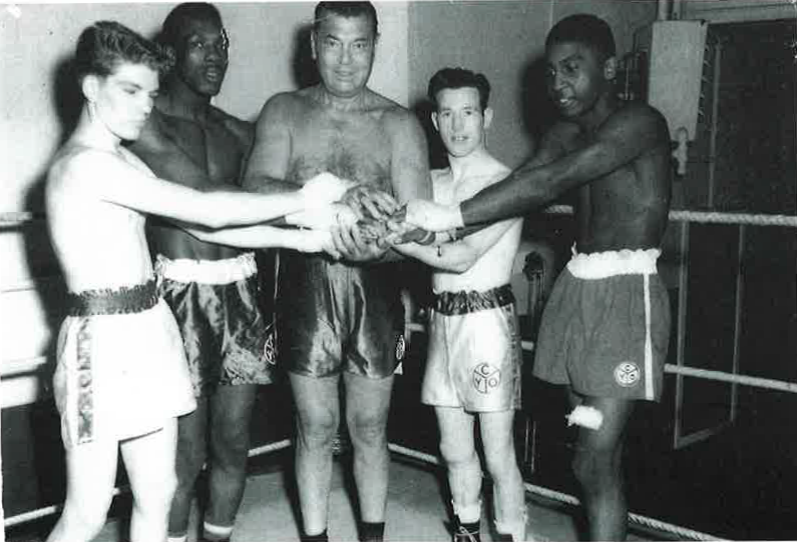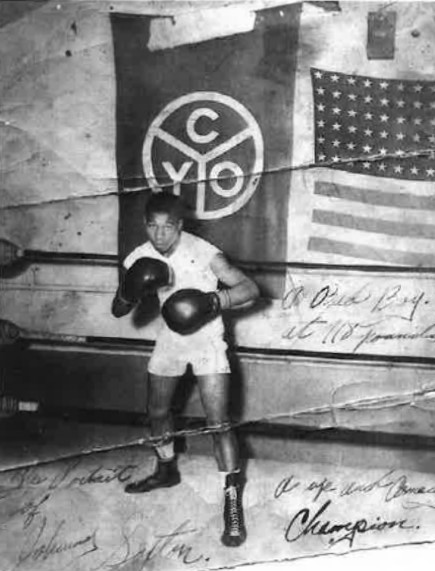Mercy Home Christmas Through the Years
As Mercy Home celebrates the end of its 130th year, we look back at the many Christmas seasons our young...
December 4, 2017
Boxing legend Jack Dempsey (middle) poses (left to right) with Brian O'Shea, Manuel Pitman, Chris Rafter, and Maurice Oliver at the CYO gymnasium in 1958 in the basement of the Mission of Our Lady of Mercy on Jackson Blvd.
August 3, 2017

Boxing legend Jack Dempsey (middle) poses (left to right) with Brian O’Shea, Manuel Pitman, Chris Rafter, and Maurice Oliver at the CYO gymnasium in 1958 in the basement of the Mission of Our Lady of Mercy on Jackson Blvd.
Ex-boxer Father Edward Kelly had a reputation for being tough. Evidence of the strong-willed fighter emerged as he led The Mission of Our Lady of Mercy through two grueling bouts in American history: The Great Depression and World War II.
During his first two decades as leader of his home for poor, abandoned, and runaway boys, Fr. Kelly maintained a close relationship with the Catholic Youth Organization (CYO), founded in 1930 by Chicago’s Archbishop Bernard J. Sheil.
Much like Fr. Kelly’s mission, the CYO sought to offer working-class Chicago youth an alternative to juvenile delinquency and welcomed young men regardless of race, ethnicity, or religion. Throughout Chicago’s Parishes, the CYO organized community-based events, social services, and summer camps that aimed to Americanize ethnic Catholics and bridge social divisions. However, the true hallmark of the CYO was athletics, in particular, its boxing program.
As America fought through the Depression and World War II, no other sport captured the country’s zeitgeist during those eras quite like boxing: the rugged, boot-strapped individual fighting for survival. And as a relatively integrated sport, minorities and other ethnic groups saw their own struggles reflected in the ring by fighters of similar heritage.
However, the economic hardships of the 1930s and military draft in the 1940s took a toll on boxing’s professional circuit. Championship purses dwindled. Popular boxers enlisted.
This hole among the pros was gladly filled by the amateur circuit, which was flourishing. In 1935, over 20,000 spectators filled Chicago Stadium to watch the CYO’s annual boxing tournament. Similar attendance trends continued on into the 1950s, especially as CYO champions automatically qualified for Chicago’s acclaimed Golden Gloves Tournament of Champions.

Hadji Shabbazz, aka Tommy Williams, the 1958 CYO 118-pound champion, works out at CYO’s boxing gym in the basement of the Mission of Our Lady of Mercy.
In 1955, when Bishop Sheil stepped down, he had an amateur sports juggernaut on his hands. Seeking a tough-minded successor with a passion for boxing and social welfare, he tapped none other than Fr. Kelly to take his place as head of the CYO. Fr. Kelly accepted the position with vigor.
“Athletics represents the finest character development program in the world. One learns the fundamentals of life, the principals [sic.] of justice, according to the rules, and courage, despite adversity,” he told the Chicago Daily Tribune in 1954. “That’s why we’re going to continue the program to the best of our ability. We are carrying on the great Bishop Sheil’s work.”
First on Fr. Kelly’s to-do list: decentralize the CYO’s activities and broaden their scope.
“Our 1955 athletic program for youth will be bigger and better than ever,” Fr. Kelly told the Chicago Daily Tribune in 1954. “We intend [on] taking our various activities directly to the boys in parishes in all sections of the Chicago archdiocese.”
This agenda shifted the CYO’s main boxing gymnasium to the basement of the Mission of Our Lady of Mercy. Fr. Kelly also established satellite CYO gymnasiums on the north, south, and west sides, in effort to increase the number of contestants in various competitions. His plan showed results: CYO teams won Chicago’s Golden Gloves team title for five consecutive years, from 1955 to 1960. Father Kelly ran the CYO for ten years, until 1965.
During the late 1950s and 1960s, the CYO’s gymnasium became a renowned halfway point for professional boxers traveling across the country. Its central location became a popular stop over where pros would train and do publicity for a few days. Boxing luminaries such as Muhammad Ali (then Cassius Clay), Tony Zale, and Jack Dempsey all visited the CYO gym.
That same facility – boxing ring, speed bags, and various training equipment – still exists to this day in Mercy Home’s basement. It continues to be the anchor for the Home’s long tradition of boxing, emblematic in our largest annual fundraiser, Ringside for Mercy’s Sake. In fact, Glenn Leonard, who trains the brokers and traders who square off in Ringside matches, was himself a CYO boxer in the early 1980s.
While the CYO boxing program and the Mission of Our Lady of Mercy were two separate entities, Fr. Kelly, nonetheless, brought a culture to the Home that emphasized discipline, sportsmanship, and the development of the physical and spiritual self. He championed amateur boxing for building strong character, courage, knowledge, and self-confidence – all qualities that Mercy Home continues to impart upon our young men and women as they spar with their own challenges in life.
As Mercy Home celebrates the end of its 130th year, we look back at the many Christmas seasons our young...
December 4, 2017
Learn how Johnny Coulon, former boxing champ, lost his title in a fight supporting Mercy Home - and still made...
October 1, 2017
To culminate our anniversary celebration, we highlight "Years of Mercy," a book by our President, Fr. Scott, about the miracles...
September 14, 2017
Does anyone R.E.M. ER Chuck Bodak?
sure. bill lerch told me he got knocked out by tony zale in a disagreement, maybe at the cyo gym.
Does anyone remember Chuck Bodak?
I remember Chuck Bodak . He was my boxing coach at the C.Y.O.